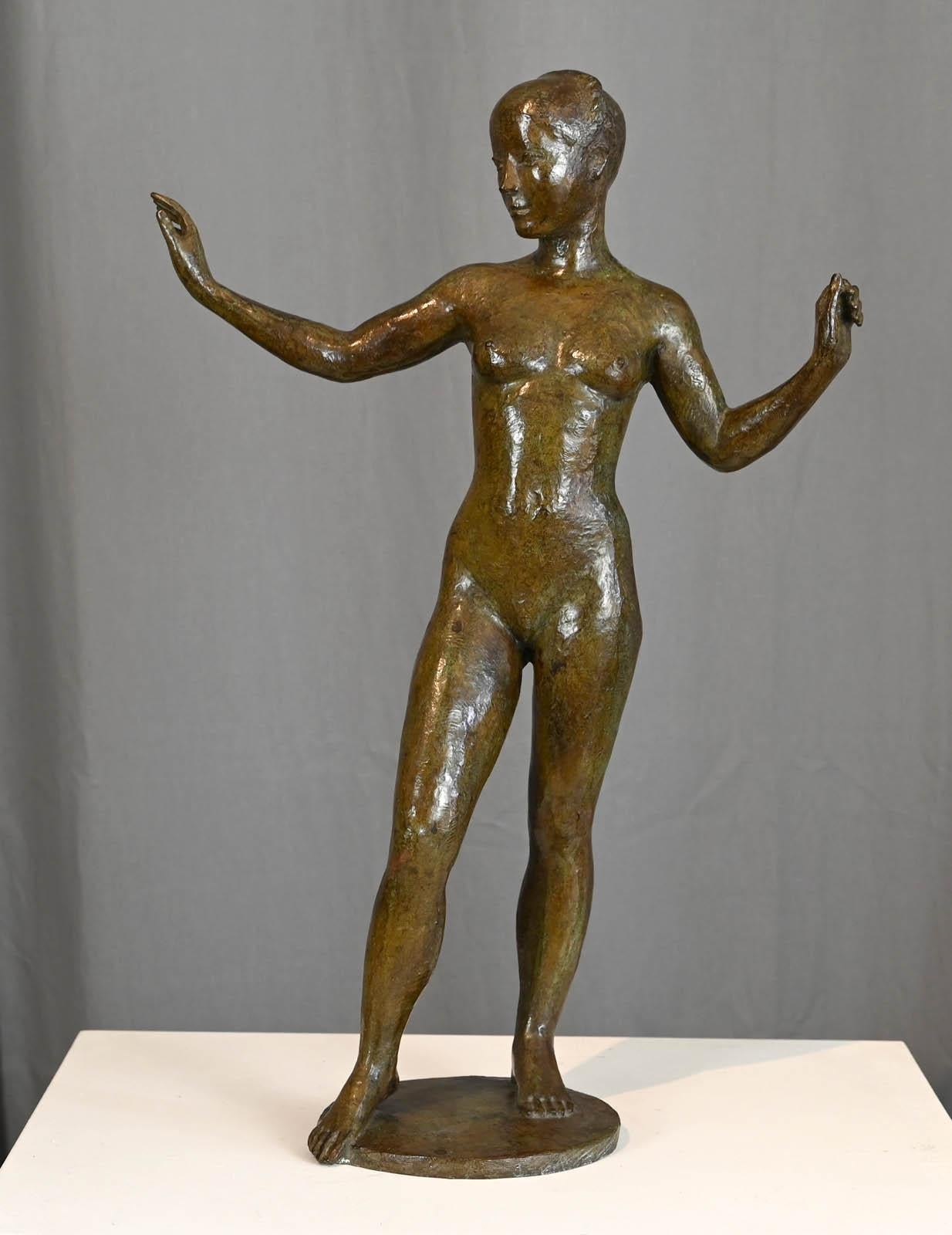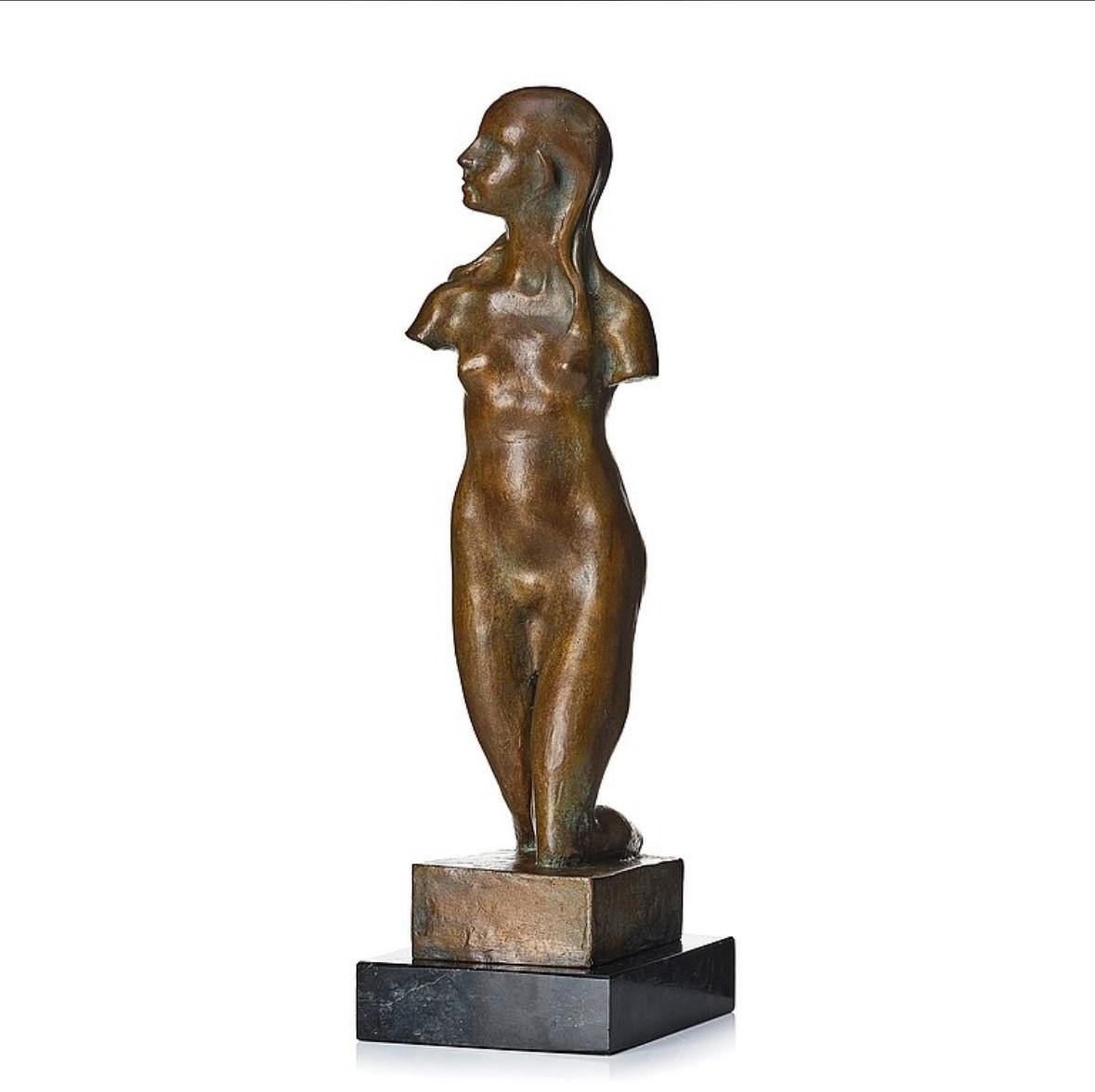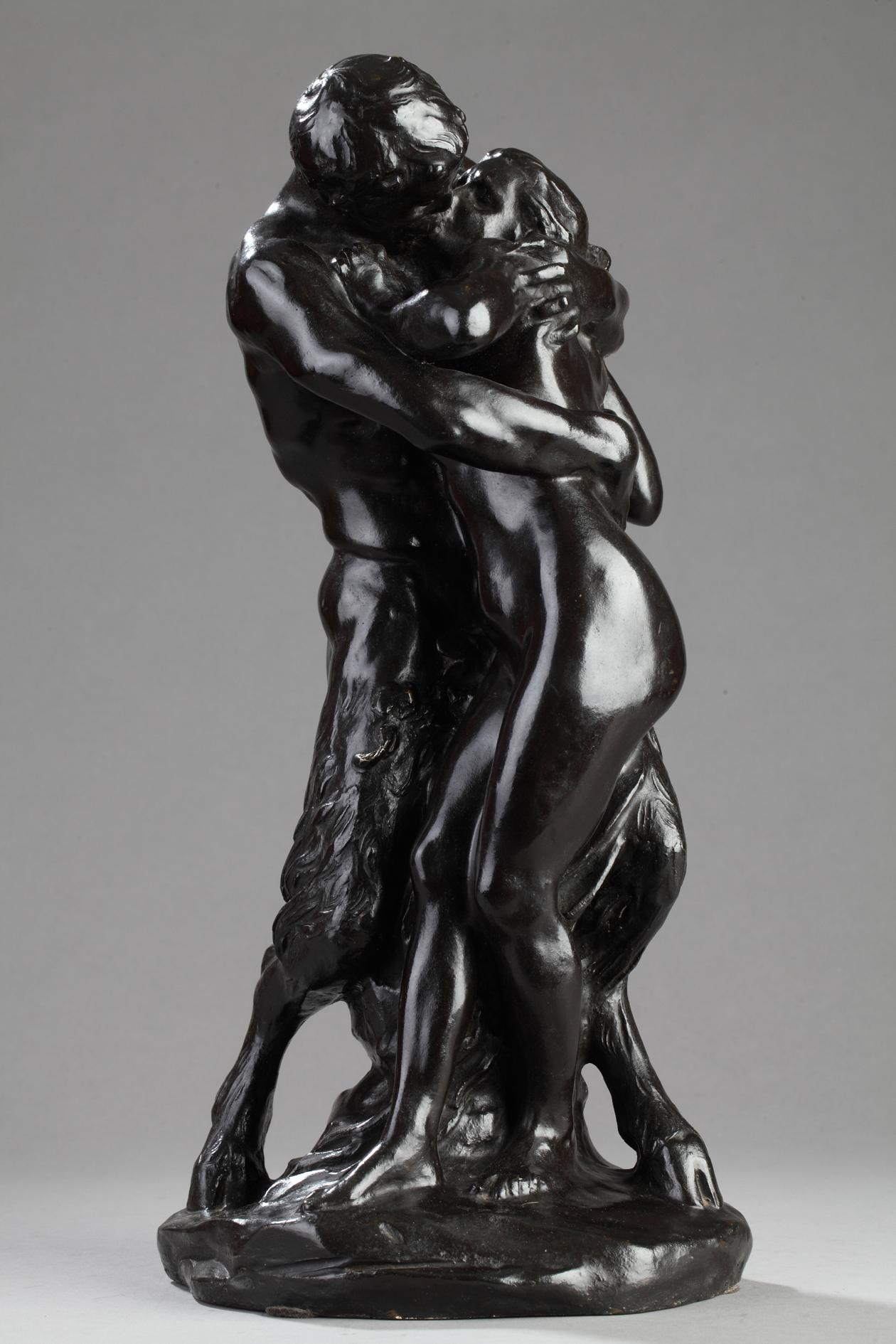Want more images or videos?
Request additional images or videos from the seller
1 of 19
Albert-Ernest Carrier-BelleuseSnake Charmercirca 1860
circa 1860
About the Item
Bronze sculpture with a nuanced dark brown patina
signed on the base "A. Carrier"
inscribed on a front plaque "Charmeuse de Serpents par Carrier-Belleuse"
France
circa 1860
height 80,5 cm
Biography :
Albert-Ernest Carrier de Belleuse known as Carrier-Belleuse (1824-1887) was one of the most prolific artists of the century and had the greatest successes under the Second Empire, enjoying the personal support of Napoleon III. His work was greatly influenced by the style of the Italian Renaissance and that of the 18th century, which he helped to bring up to date.
In 1837, the young Carrier-Belleuse apprenticed in the workshop of the engraver Bauchery. He was admitted soon after to the goldsmith Jacques Henri Fauconnier. Through François Arago, he met the sculptor David d'Angers who facilitated his admission to the School of Fine Arts. Carrier-Belleuse entered it in 1840. Noted for his skill by the great bronze companies in Paris such as Barbedienne and Denière, he soon received numerous orders for models for candelabras, pendulums, fittings for fireplaces, etc. In 1848, probably at the initiative of François Arago, who became head of state, he received his first public order for a small statue of "Mademoiselle Rachel singing La Marseillaise". In 1851, he appeared for the first time at the Salon of French Artists, where he presented two bronze medallions. From 1851 to 1855, Carrier-Belleuse stayed in England, in Stoke-on-Trent where he served as director of the modeling and drawing school of the Minton house, a large porcelain manufacturer.
Back in France, Carrier-Belleuse moved to Paris in a large workshop located 15 rue de la Tour d´Auvergne. From 1857, he made regular sendings to the Salon and became famous thanks to the success of large marbles, such as the "Bacchante" exhibited at the Salon in 1863, and acquired by Napoleon III, "Angelica" (1866) or even "Hebe asleep" (1869). At the Salon of 1867, his group entitled "Messiah" earned him the medal of honor of sculpture. It was acquired by the State to adorn the Chapel of the Virgin in the Saint-Vincent-de-Paul church.
Carrier-Belleuse acquired a great reputation in parallel for his terracotta busts which, in many respects, recall those of 18th century artists. He made portraits of a large number of celebrities of his time. He produced, among others, the busts of Napoleon III, Renan, Thiers, Grévy, Arago, Marguerite Bellanger, Théophile Gautier, Honoré Daumier, Delacroix, Hortense Schneider, Réjane… He also modelled numerous busts of mythological inspiration and historical and artistic portraits like Marie Stuart, Shakespeare or even Mozart.
Carrier-Belleuse used and trained in his workshop in the rue de la Tour d´Auvergne many young talented artists such as Alexandre Falguière, Jules Desbois, Eugène Delaplanche, Jules Dalou or Joseph Chéret; but he was best known for having been the master of Auguste Rodin who entered his studio as a practitioner in 1864.
Carrier-Belleuse devoted himself a lot to decorative sculpture. He contributed to the decorations of many important buildings. We owe him in particular the caryatids of the Renaissance theater in Paris, the pediment of the main entrance to the Banque de France, the stucco ceilings of the Lesdiguières and La Trémoïlle pavilions at the Louvre Palace, the frieze of the Palais de la Bourse in Brussels, or the decoration of the Hôtel de la Païva on the Champs-Elysées in Paris. He also received State commissions for monuments: that of Jean-Jacques Rousseau in Montmorency, of Alexandre Dumas, in Villers-Cotterêts, of Masséna in Nice. Abroad, he produced the equestrian statue of Michael the brave in Bucharest and the tomb of José de San Martín in Buenos Aires.
In 1873, Carrier-Belleuse took part in the construction of the Paris Opera house, directed by his friend Charles Garnier. He created the two monumental torchieres flanking the grand staircase in the main hall and the caryatids of the chimney of the grand foyer. In 1875, he was appointed director of works of art at the Porcelain Manufacture de Sèvres. He imprinted on it a very modern impulse which manifested itself in the creation of a complete range of vases.
- Creator:Albert-Ernest Carrier-Belleuse (1824 - 1887, French)
- Creation Year:circa 1860
- Dimensions:Height: 31.7 in (80.5 cm)Width: 9.06 in (23 cm)Depth: 11.03 in (28 cm)
- Medium:
- Movement & Style:
- Period:
- Condition:
- Gallery Location:PARIS, FR
- Reference Number:
Albert-Ernest Carrier-Belleuse
Albert-Ernest Carrier-Belleuse was a French sculptor. Carrier-Belleuse was born on 12th June 1824 at Anizy-le-Château, Aisne, France. He began his training as a goldsmith's apprentice. He was a student of David d'Angers and briefly studied at the École des Beaux-Arts. His career is distinguished by his versatility and his work outside France, in England between 1850–55 and in Brussels around 1871. His name is perhaps best known because Auguste Rodin worked as his assistant between 1864 and 1870. The two traveled to Brussels in 1871 and by some accounts, Rodin assisted Carrier-Belleuse's architectural sculpture for the Brussels Stock Exchange.

About the Seller
5.0
Vetted Seller
These experienced sellers undergo a comprehensive evaluation by our team of in-house experts.
Established in 1992
1stDibs seller since 2023
Typical response time: 20 hours
- ShippingRetrieving quote...Ships From: PARIS, France
- Return PolicyA return for this item may be initiated within 3 days of delivery.
More From This SellerView All
- The KissBy Aimé-Jules DalouLocated in PARIS, FRThe Kiss also named "Nymph and Faun" by Jules DALOU (1838-1902) A bronze group with a black patina Signé "Dalou" A very fine cast by "A.A. Hébrard" (with the foundry stamp) The ca...Category
Early 1900s French School Figurative Sculptures
MaterialsBronze
- Young woman seated with draperyLocated in PARIS, FRYoung woman seated with drapery by Pierre-Marie POISSON (1876-1953) Bronze sculpture with nuanced green patina signed on the base "P. Poisson" old cast France circa 1935-40 height 21,5 cm length 24,5 cm depth 11 cm Biography : Pierre-Marie Poisson (1876-1953) was a French sculptor and medalist. He studied sculpture at the Ecole des Beaux-Arts in Toulouse from 1893 to 1896, where he trained in plaster works. He completed this teaching in the Barrias studio in Paris. He began to exhibit his works in 1899 at the Society of French Artists and in 1907 obtained a medal of honor at the Salon as well as an allowance to reside at the villa Abd-el-Tif in Algiers where he designed and produced the decorations. He returned there regularly until 1914. After the Great War, Poisson collaborated with the Compagnie des Arts Français with Süe and Mare. In 1922 the city of Niort commissioned Poisson a war memorial located on the esplanade of the keep. Poisson created the monument to the dead in Le Havre in 1925, considered his masterpiece. He participated in various decorative works : lounge of the Paquebot...Category
1930s French School Nude Sculptures
MaterialsBronze
- The ComedyLocated in PARIS, FRPierre-Marie POISSON (1876-1953) The Comedy Bronze sculpture with black patina signed on the base "P. Poisson" Cast by Valsuani (with the foundry stamp) Raised on a stone base Fra...Category
1930s French School Figurative Sculptures
MaterialsBronze
- Diana with an arrowBy Albert-Ernest Carrier-BelleuseLocated in PARIS, FRDiana with an arrow by Albert-Ernest CARRIER-BELLEUSE (1824-1887) Bronze sculpture with a dual light and dark brown patina signed on the base "Carrier-Belleuse" inscribed on a front plaque "Diane à la Flèche par Carrier-Belleuse (Sculptr)" France circa 1870 height 83 cm arrow added probably in the 20th c. Biography : Albert-Ernest Carrier de Belleuse known as Carrier-Belleuse (1824-1887) was one of the most prolific artists of the century and had the greatest successes under the Second Empire, enjoying the personal support of Napoleon III. His work was greatly influenced by the style of the Italian Renaissance and that of the 18th century, which he helped to bring up to date. In 1837, the young Carrier-Belleuse apprenticed in the workshop of the engraver Bauchery. He was admitted soon after to the goldsmith Jacques Henri Fauconnier. Through François Arago, he met the sculptor David d'Angers who facilitated his admission to the School of Fine Arts. Carrier-Belleuse entered it in 1840. Noted for his skill by the great bronze companies in Paris such as Barbedienne and Denière, he soon received numerous orders for models for candelabras, pendulums, fittings for fireplaces, etc. In 1848, probably at the initiative of François Arago, who became head of state, he received his first public order for a small statue of "Mademoiselle Rachel singing La Marseillaise". In 1851, he appeared for the first time at the Salon of French Artists, where he presented two bronze medallions. From 1851 to 1855, Carrier-Belleuse stayed in England, in Stoke-on-Trent where he served as director of the modeling and drawing school of the Minton house, a large porcelain manufacturer. Back in France, Carrier-Belleuse moved to Paris in a large workshop located 15 rue de la Tour d´Auvergne. From 1857, he made regular sendings to the Salon and became famous thanks to the success of large marbles, such as the "Bacchante" exhibited at the Salon in 1863, and acquired by Napoleon III, "Angelica" (1866) or even "Hebe asleep" (1869). At the Salon of 1867, his group entitled "Messiah" earned him the medal of honor of sculpture. It was acquired by the State to adorn the Chapel of the Virgin in the Saint-Vincent-de-Paul church. Carrier-Belleuse acquired a great reputation in parallel for his terracotta busts which, in many respects, recall those of 18th century artists. He made portraits of a large number of celebrities of his time. He produced, among others, the busts of Napoleon III, Renan, Thiers, Grévy, Arago, Marguerite Bellanger, Théophile Gautier, Honoré Daumier, Delacroix, Hortense Schneider, Réjane… He also modelled numerous busts of mythological inspiration and historical and artistic portraits like Marie Stuart, Shakespeare or even Mozart. Carrier-Belleuse used and trained in his workshop in the rue de la Tour d´Auvergne many young talented artists such as Alexandre Falguière, Jules Desbois...Category
1870s French School Nude Sculptures
MaterialsBronze
- Woman taking off her shirtLocated in PARIS, FRWoman taking off her shirt by James PRADIER (1790-1852) Bronze with a nuanced brown patina cast by SOYER and INGE France circa 1850 height 28,5 cm Biography : Jean-Jacques Pradier...Category
1850s French School Nude Sculptures
MaterialsBronze
- Important pocket-tray with sea godsLocated in PARIS, FRImportant pocket-tray with sea gods by Gustave MICHEL (1851-1924) A very fine bronze group with a gilded patina signed on the side of the base "G. Michel" cast by "Siot-Decauville ...Category
1890s French School Nude Sculptures
MaterialsBronze
You May Also Like
- MarieLocated in LE HAVRE, FRJacques COQUILLAY (né en 1935) Marie Original bronze Size : 56x39x17cm Copy No. 4/8 Signature and numbered on the base. Original bronze made with ...Category
Early 2000s French School Nude Sculptures
MaterialsBronze
- Female torsoLocated in Täby, SEThis female torso represents the young woman's strength and vulnerability. It´s was conceived in the 70ths and is signed with the artists initials on a thumbprint. Gunnar Knut Nilsson, born 1904 in Karlskrona, died 1995 in Versailles in France, was a Swedish sculptor. Gunnar Nilsson studied watercolor painting and modeling at the Technical Vocational School in Karlskrona in 1918-19 and on his own in addition to working as a clerk at Finspångs Metallwerk. His debut exhibition was in Finspång in 1927. With the help of a local fundraiser, and after the encouragement of Carl Eldh, he traveled to Paris in 1928 to study sculpture for, among others, Charles Despiau and Paul Niclausse. In Paris he socialized with Bror Hjorth, whose former studio he also rented, Carl Frisendahl and Alberto Giacometti. He came to belong to "Le groupe des Neuf'' with Paul Cornet...Category
1950s French School Nude Sculptures
MaterialsBronze
- VictoireLocated in LE HAVRE, FRJacques COQUILLAY (né en 1935) Victoire Original bronze Size : 105 x 22 x 20 cm Copy No. 1/8 Signature and numbered on the base. Original bronze m...Category
Early 2000s French School Nude Sculptures
MaterialsBronze
- Fleur – Charlotte by Nando Kallweit. Bronze sculpture, Edition of 50By Nando KallweitLocated in Coltishall, GBFleur – Charlotte is an elegant figurative bronze sculpture by Nando Kallweit. Inspired by the the legend of the phoenix, this female figure has graceful wings instead of arms. The...Category
21st Century and Contemporary Other Art Style Figurative Sculptures
MaterialsBronze
- 20th Century Solid Bronze Nude Ballet Dancer 'Preparation' by Benson LandesBy Benson LandesLocated in Shrewsbury, Shropshire'Preparation' is a 20th Century Solid Bronze ballet Dancer by Benson Landes. For Benson Landes, sculpture was most definitely a passion. His oeuvre of cast bronzes is populated wit...Category
Late 20th Century Realist Nude Sculptures
MaterialsBronze
- 'Libri' Figurative Nude bronze Sculpture of a Woman reading a book, dancer, goldBy Carl PayneLocated in Shrewsbury, Shropshire'Libri' is a stunning sculpture by the hugely talented Carl Payne. Payne has a talent to create a real feeling of movement and lightness in his Bronze sculptures, no small feat! Continuing a successful career in England and Ireland, Carl joined Callaghan Fine Paintings and Works of Art at the beginning of 2004 in order to dedicate his time to create and develop stunning individual contemporary sculpture. Carl is a Staffordshire based sculptor for whom art has played a large part in his academic work taking him through the Burslem School of Art, the Henry Doulton School of Sculpture and then to Stafford College. After qualifying in Figurative Sculpture he launched his career with commission after commission which has now secured his reputation for fine quality workmanship both in life-size format and smaller decorative pieces. The list of his completed commissioned work is extensive, including many ‘house-hold’ names from the sporting world, commerce and the past. The following are just some of the private and publicly commissioned completed works that form Carl’s prestigious portfolio:- King George 5th and Queen Mary – life size portrait buste commissioned by Cunards Cruise Ships and located in the ballroom of the Queen Mary 2 (QM2) cruise ship. Ride a Cock Horse to Banbury Cross – life size and a quarter commissioned by Banbury Council, located at Banbury Cross and unveiled by Princess Anne. Randolph Turpin – life size and a quarter - commissioned by Warwick and Leamington Spa Council located in Warwick Town Centre, Sir Stanley Matthews – life size and a half - commissioned by the Stanley Matthews Foundation located at The Britannia Stadium, Stoke. George Best...Category
21st Century and Contemporary Nude Sculptures
MaterialsBronze



